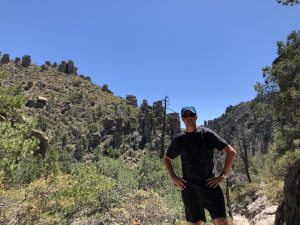 I just returned from running in Chiricahua National Monument, Sedona, Painted Desert, and Petrified Forest National Park, taking advantage of the late spring before the heat becomes too intense. Even so, though I got to Massai Point in Chiricahua through 90+ degree canyons and had around a liter of water left, I still had to slow down and walk out after running short of liquid nourishment two-thirds down. There is an eerie, uncertain nausea that hits when hydration runs low under high stress. Cliffs and steep ravines take on a wolfish quality. The mind works to control feet against stumbling and the lips get serrated edges of parched skin that bite off without relieving the dryness.
I just returned from running in Chiricahua National Monument, Sedona, Painted Desert, and Petrified Forest National Park, taking advantage of the late spring before the heat becomes too intense. Even so, though I got to Massai Point in Chiricahua through 90+ degree canyons and had around a liter of water left, I still had to slow down and walk out after running short of liquid nourishment two-thirds down. There is an eerie, uncertain nausea that hits when hydration runs low under high stress. Cliffs and steep ravines take on a wolfish quality. The mind works to control feet against stumbling and the lips get serrated edges of parched skin that bite off without relieving the dryness.
I would remember that days later as I prepped to overnight with a wilderness permit in Petrified Forest only to discover that my Osprey Exos pack frame had somehow been bent, likely due to excessive manhandling by airport checked baggage weeks earlier. I considered my options and drove eighty miles to Flagstaff to replace the pack, then back again.
I arrived in time to join Dr. Richard Carrier in an unexpected dive bar in Holbrook, Arizona as the sunlight turned to amber and a platoon of Navajo pool sharks descended on the place for billiards and beers. I had read that Dr. Carrier would be stopping there and it was convenient to my next excursion, so I picked up signed copies of his new book, The Scientist in the Early Roman Empire, as well as his classic, On the Historicity of Jesus, that remains part of the controversial samizdat of so-called “Jesus mythicism.”
If there is a distinguishing characteristic of OHJ it is the application of Bayesian Theory to the problems of historical method.… Read the rest